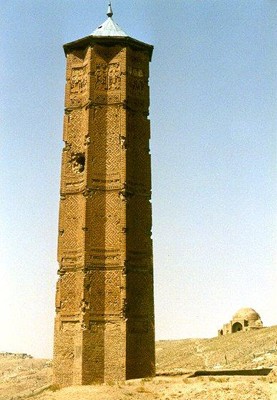By Sayed Salahuddin
GHAZNI - For more than eight centuries the "Towers of Victory" -- monuments to Afghanistan's greatest empire -- have survived wars and invasions, but now weather and neglect could cause them to come crashing down.
From its base in the Afghan city of Ghazni, the dynasty of Sultan Mahmoud Ghaznavi extended its rule to stretch from the River Tigris in modern day Iraq to the River Ganges in India.
The two toffee-colored minarets, adorned with terra-cotta tiles were raised in the early 12th century as monuments to the victories of the Afghan armies that built the empire.
Since then, Afghanistan has more often been victim of invasion than the perpetrator of them.
The upper portions of the Towers of Victory have eroded away over time, so now only the bases remain -- though they still stand at around 7 meters (24 feet) tall.
"If attention is not paid, there is the possibility they will be destroyed," said Aqa Mohammad Khoshazada, a senior official with Ghazni's culture and information department. "Floods and rain in spring and snow in winter all end up around the minarets."
Ghazni is regarded as the cradle of Afghan culture and arts and during his rule Mahmoud had attracted 400 scholars and poets to his court. But the sultan was also an iconoclast who destroyed hundreds of Hindu statues during campaigns to introduce Islam into India.
Mahmoud died in 1030. His son, Sultan Masud, built one of the minarets. The other was erected by another successor.
The Ghaznavis' rule lasted for more than two centuries.
The city was then razed to the ground by Allauddin Ghori from central Afghanistan, who earned the nickname of "World Burner" for the massacre of Ghazni's people in an orgy of destruction and looting.

RAWA: Afghanistan’s National Museum, established in the 1920s and acknowledged as one of the world’s most opulent depositories, had also become a victim of fighting among the fundamentalists. After the invasion of Kabul in 1992 the corrupt and uncivilized warriors plundered the whole museum and turned its building into ashes. Many historical relics were destroyed and the precious collections of the museum lay in ruins.
The city flourished again, only to be destroyed again by a son of Ghenghiz Khan in 1221. But the minarets survived.
Ghazni changed hands between British and Afghan forces several times in the 19th century suffering more sieges and massacres. More fighting during the Soviet occupation of the 1980s, followed by the civil war of the 1990s, also left their mark on Ghazni.
Ghazni's Towers of Victory stand several hundred meters away from each other and lie at the bottom of a hill.
Holes and ditches, made by illegal excavations for antiquities and buried treasure collect water and are now undermining the foundations of the minarets.
One has panels of bold Kufic lettering on the top. The tops of the towers are capped with corrugated iron, after the upper sections came down in an earthquake.
But despite repeated appeals and warnings, Afghanistan's impoverished central government, fighting a Taliban insurgency, has allocated just $100 dollars in six years to fill some of the holes around the towers, said Sayed Wali the head of the culture department in Ghazni.
"They are under threat and we have no resources to stop it," Wali said.




